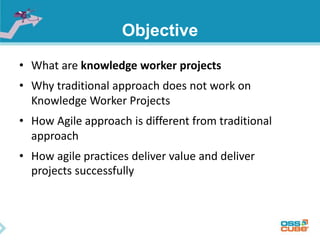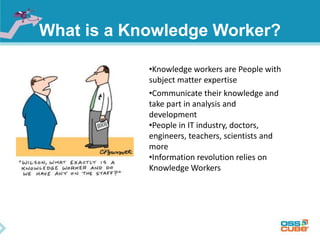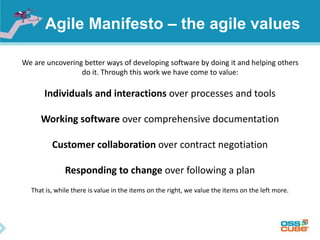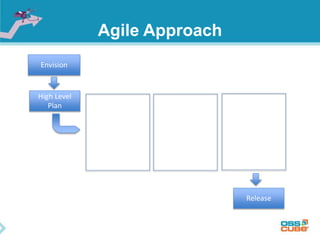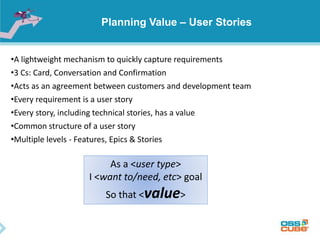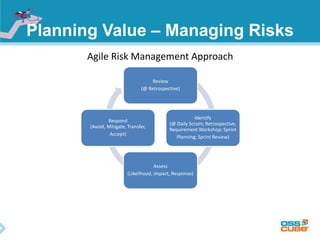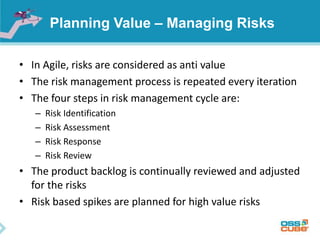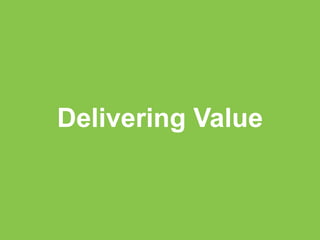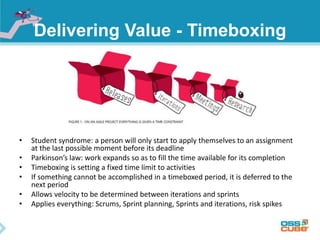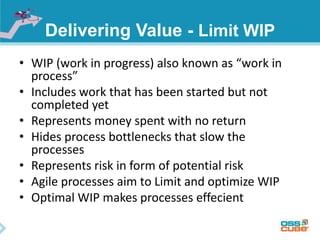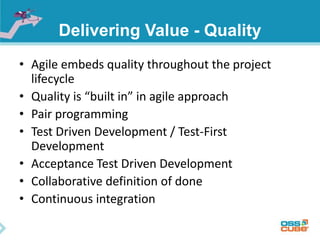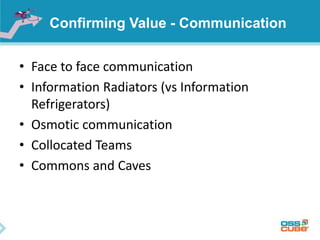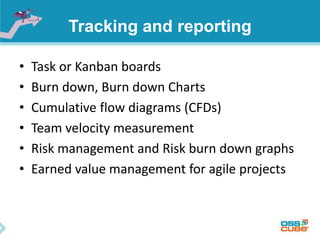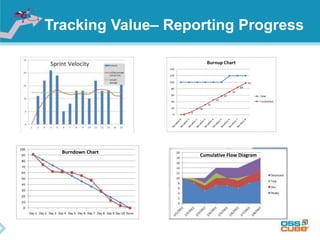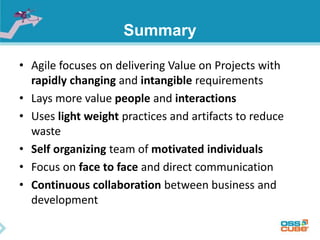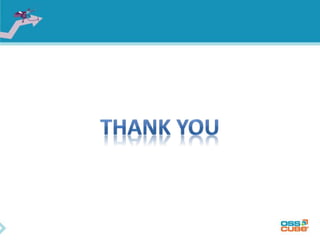Value-Driven-Delivery
- 1. Feb 16, 2015 Ram Awadh Prasad Value Driven Development with Agile
- 2. Objective • What are knowledge worker projects • Why traditional approach does not work on Knowledge Worker Projects • How Agile approach is different from traditional approach • How agile practices deliver value and deliver projects successfully
- 3. Knowledge Worker Projects • We are going through information revolution. • The key lies in Ownership of knowledge and ability to use it to create goods and services. • On Knowledge Worker projects work is intangible • Requirements are rapidly changing • Decisions are more important than structure • Continuous innovation, focus on quality and adaptability are the keys to success.
- 4. What is a Knowledge Worker? •Knowledge workers are People with subject matter expertise •Communicate their knowledge and take part in analysis and development •People in IT industry, doctors, engineers, teachers, scientists and more •Information revolution relies on Knowledge Workers
- 6. 2 Traditional Project Management Approach • Plan centric and plan driven • Focus of processes, tools and extensive documentation • Command and control style leadership • Prescriptive - or “Push approach” - for managing projects • Resistant to change – elaborate change management process • Tracking through complex reports and metrics
- 7. Agile Manifesto – the agile values We are uncovering better ways of developing software by doing it and helping others do it. Through this work we have come to value: Individuals and interactions over processes and tools Working software over comprehensive documentation Customer collaboration over contract negotiation Responding to change over following a plan That is, while there is value in the items on the right, we value the items on the left more.
- 9. 2 Agile Approach • Value driven - early and continuous delivery of value • Focus on people and interactions • Cross functional Self organizing teams • Agility is everyone’s Responsibility • Embrace changes even late in development • Working software as the primary measure of progress
- 10. Planning Value
- 11. Planning Value – Six Levels of Planning Organization focus • Strategy: Business goals and roadmaps agreed by the Executive Leadership • Portfolio: Selection of the products that will best implement the vision • Product: Looking and planning for the evolution of released system Team focus • Release: Features of each release that support the Product plan • Iteration: Tasks needed to transform a feature request into working, tested software • Daily: Daily Scrum and work activities
- 12. 2 Planning Value – Product Backlog, Release, Sprint Product Road Map • Visual overview of product’s releases and its main components • Provides a quick view of primary release points and intended functionality Product Backlog • Contains all user stories, themes, and epics. • Product owner prioritizes features, epics and stories on their value • If something is not in the product backlog, it is not in the product Release • Releases are used to support product roadmaps • Product owner selects the items from the backlog that meet the goals of a release.
- 13. 2 Planning Value – Value Based Prioritization • Valued based prioritization is the one of the core practices in agile planning • Features are prioritized on the basis of business value, risk and dependencies. • Some of the prioritization techniques used: • MoSCoW prioritization: Requirements are prioritized based on Must, Should, Could, and Won’t. • Kano Analysis: Threshold, Linear, Exciters/Delighters, Indifferent • Relative prioritization: Each feature is prioritized based on its relative weighting for Benefits, Penalties, Costs, and Risk • Minimal Marketable Features: Smallest set of functionality that provides value to the market
- 14. Planning Value – User Stories •A lightweight mechanism to quickly capture requirements •3 Cs: Card, Conversation and Confirmation •Acts as an agreement between customers and development team •Every requirement is a user story •Every story, including technical stories, has a value •Common structure of a user story •Multiple levels - Features, Epics & Stories As a <user type> I <want to/need, etc> goal So that <value>
- 15. Planning Value – Managing Risks Identify Risks Quantitative Risk Analysis Qualitative Risk Analysis Plan Risk Responses Monitor and Control Risks Traditional Risk Management Approach •Risk identification, analysis and planning is largely done at the during planning •Responsibility of risk responses may lie on different individuals •One responses are planned implementation is more often than not forgotten
- 16. Planning Value – Managing Risks Agile Risk Management Approach Review (@ Retrospective) Identify (@ Daily Scrum; Retrospective; Requirement Workshop; Sprint Planning; Sprint Review) Assess (Likelihood, impact, Response) Respond (Avoid, Mitigate, Transfer, Accept)
- 17. Planning Value – Managing Risks • In Agile, risks are considered as anti value • The risk management process is repeated every iteration • The four steps in risk management cycle are: – Risk Identification – Risk Assessment – Risk Response – Risk Review • The product backlog is continually reviewed and adjusted for the risks • Risk based spikes are planned for high value risks
- 18. Delivering Value
- 19. Delivering Value - Timeboxing • Student syndrome: a person will only start to apply themselves to an assignment at the last possible moment before its deadline • Parkinson’s law: work expands so as to fill the time available for its completion • Timeboxing is setting a fixed time limit to activities • If something cannot be accomplished in a timeboxed period, it is deferred to the next period • Allows velocity to be determined between iterations and sprints • Applies everything: Scrums, Sprint planning, Sprints and iterations, risk spikes
- 20. Delivering Value - Task Board • An "information radiator" - ensures efficient diffusion of information • Can be drawn on a whiteboard or even a section of wall • Makes iteration backlog visible • Serves as a focal point for the daily meeting • Story cards can be quickly and easily moved to update status
- 21. Delivering Value - Limit WIP • WIP (work in progress) also known as “work in process” • Includes work that has been started but not completed yet • Represents money spent with no return • Hides process bottlenecks that slow the processes • Represents risk in form of potential risk • Agile processes aim to Limit and optimize WIP • Optimal WIP makes processes effecient
- 22. Delivering Value - Quality • Agile embeds quality throughout the project lifecycle • Quality is “built in” in agile approach • Pair programming • Test Driven Development / Test-First Development • Acceptance Test Driven Development • Collaborative definition of done • Continuous integration
- 23. Delivering Value – Continuous Improvement • Daily standup • Sprint demos • Retrospectives • Highest value on quality • Continuous Integration • Process Improvement
- 24. Confirming Value
- 25. Confirming Value - Communication
- 26. Confirming Value - Communication • Face to face communication • Information Radiators (vs Information Refrigerators) • Osmotic communication • Collocated Teams • Commons and Caves
- 27. Agile Communication - Information Radiators
- 28. Confirming Value • Customer-valued prioritization • Feedback – Prototypes – Simulation – Demonstration – Evaluation
- 30. Tracking and reporting • Task or Kanban boards • Burn down, Burn down Charts • Cumulative flow diagrams (CFDs) • Team velocity measurement • Risk management and Risk burn down graphs • Earned value management for agile projects
- 31. Tracking Value– Reporting Progress Burndown Chart Cumulative Flow Diagram
- 32. Tracking Value– Reporting Risks
- 33. Summary
- 34. Summary • Agile focuses on delivering Value on Projects with rapidly changing and intangible requirements • Lays more value people and interactions • Uses light weight practices and artifacts to reduce waste • Self organizing team of motivated individuals • Focus on face to face and direct communication • Continuous collaboration between business and development


